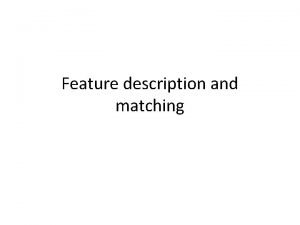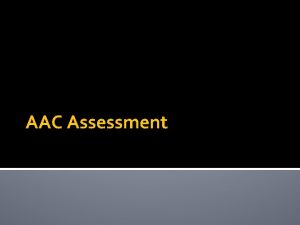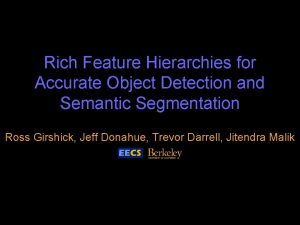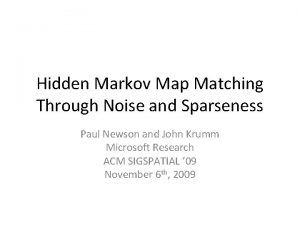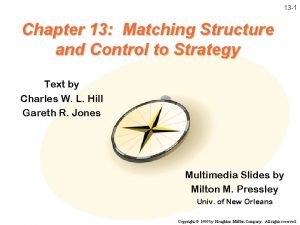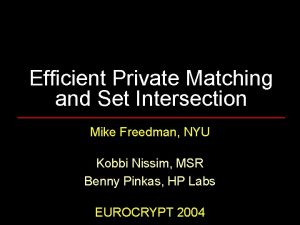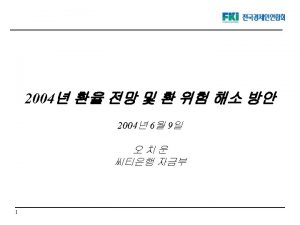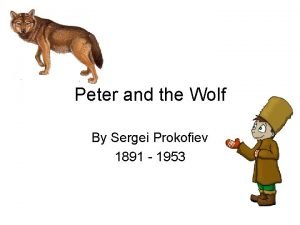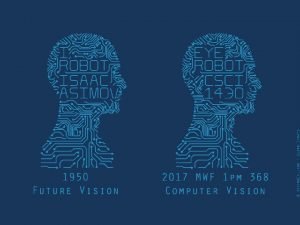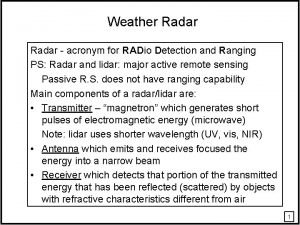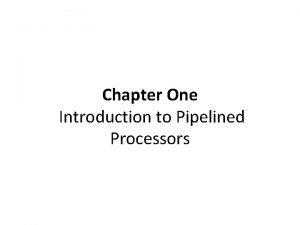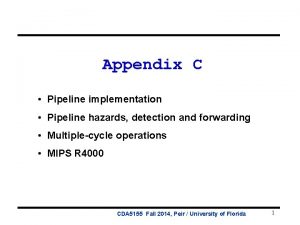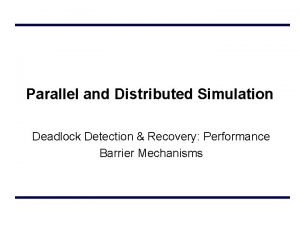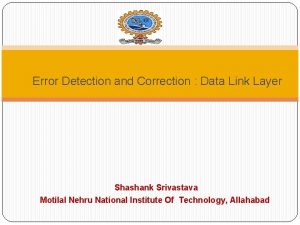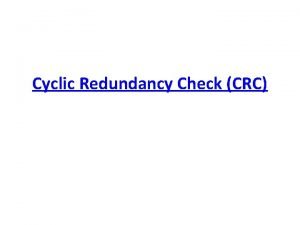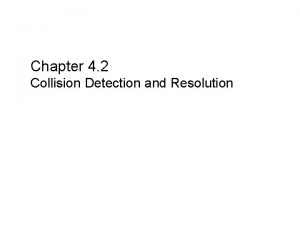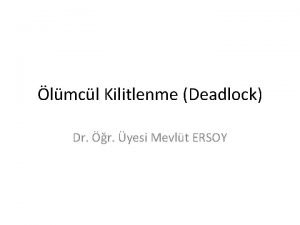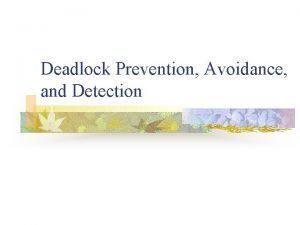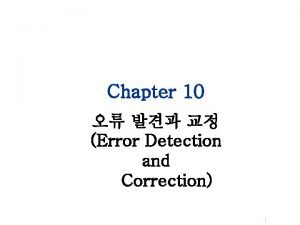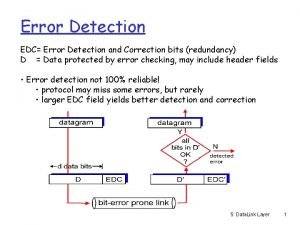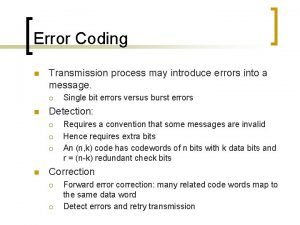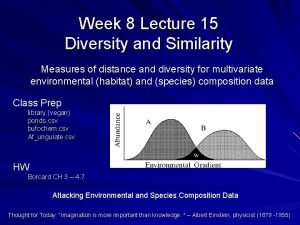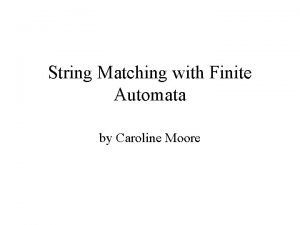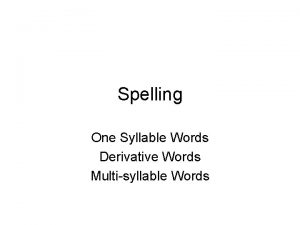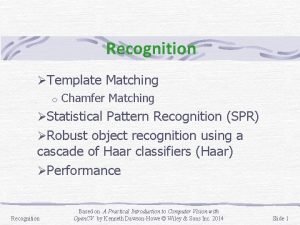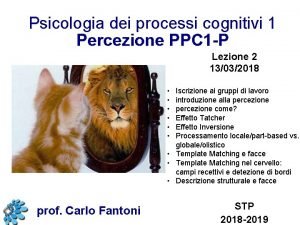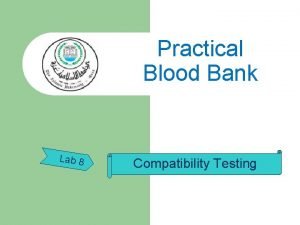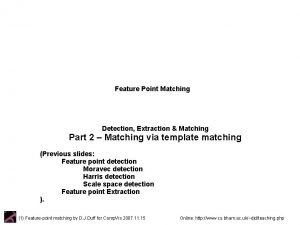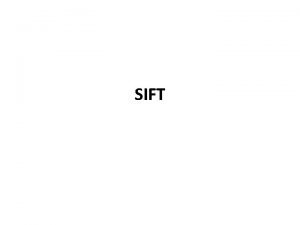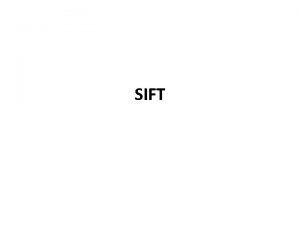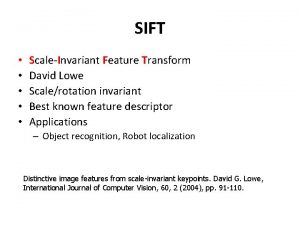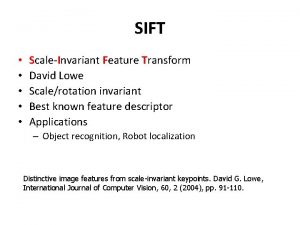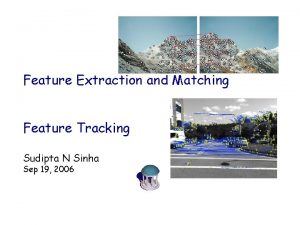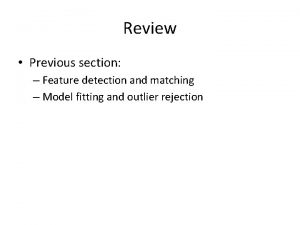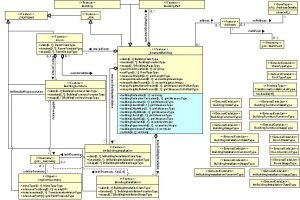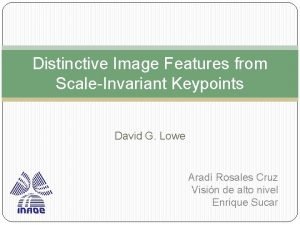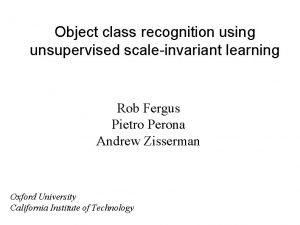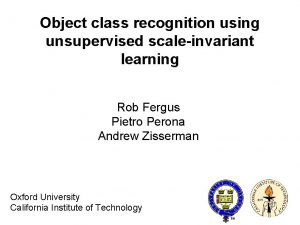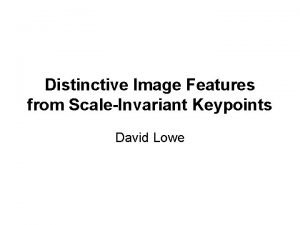Scaleinvariant Feature Detection Feature description and matching Announcements























































- Slides: 55

Scale-invariant Feature Detection Feature description and matching

Announcements • HW 1 and PA 2 out tonight or tomorrow • Schedule will be updated shortly • Artifact voting out today • Please vote

Feature extraction: Corners 9300 Harris Corners Pkwy, Charlotte, NC Slides from Rick Szeliski, Svetlana Lazebnik, and Kristin Grauman

The second moment matrix The surface E(u, v) is locally approximated by a quadratic form. Let’s try to understand its shape.

E(u, v) u v

Interpreting the second moment matrix Consider a horizontal “slice” of E(u, v): This is the equation of an ellipse. Diagonalization of M: The axis lengths of the ellipse are determined by the eigenvalues and the orientation is determined by R direction of the fastest change direction of the slowest change ( max) -1/2 ( min)-1/2

Corner detection: the math xmin xmax M M Eigenvalues and eigenvectors of M • Define shift directions with the smallest and largest change in error • xmax = direction of largest increase in E • max = amount of increase in direction xmax • xmin = direction of smallest increase in E • min = amount of increase in direction xmin

The Harris operator min is a variant of the “Harris operator” for feature detection • The trace is the sum of the diagonals, i. e. , trace(H) = h 11 + h 22 • Very similar to min but less expensive (no square root) • Called the “Harris Corner Detector” or “Harris Operator” • Actually the Noble variant of the Harris Corner Detector • Lots of other detectors, this is one of the most popular

Corner response function Corner Edge Flat patch

Corner detection summary Here’s what you do • Compute the gradient at each point in the image • Create the M matrix from the entries in the gradient • Compute the eigenvalues. • Find points with large response ( min > threshold) • Choose those points where min is a local maximum as features

Harris features (in red)

Harris Corners – Why so complicated? • Can’t we just check for regions with lots of gradients in the x and y directions? • No! A diagonal line would satisfy that criteria Current Window

Image transformations • Geometric Rotation Scale • Photometric Intensity change

Invariance and covariance • We want corner locations to be invariant to photometric transformations and covariant to geometric transformations • Invariance: image is transformed and corner locations do not change • Equivariance: if we have two transformed versions of the same image, features should be detected in corresponding locations

Image translation • Derivatives and window function are shift-invariant Corner location is equivariant w. r. t. translation

Image rotation Second moment ellipse rotates but its shape (i. e. eigenvalues) remains the same Corner location is equivariant w. r. t. rotation

Affine intensity change I a. I+b • Only derivatives are used => invariance to intensity shift I I + b • Intensity scaling: I a I R R threshold x (image coordinate) Partially invariant to affine intensity change

Harris Detector: Invariance Properties • Scaling Corner All points will be classified as edges Not invariant to scaling

So far: can localize in x-y, but not scale

Scale invariant detection Suppose you’re looking for corners Key idea: find scale that gives local maximum of f • in both position and scale • One definition of f: the Harris operator

Lindeberg et al, et 1996 Lindeberg al. , 1996 Slidefrom. Tinne. Tuytelaars






Implementation • Instead of computing f for larger and larger windows, we can implement using a fixed window size with a Gaussian pyramid

Feature extraction: Corners and blobs

Another common definition of f • The Laplacian of Gaussian (Lo. G) (very similar to a Difference of Gaussians (Do. G) – i. e. a Gaussian minus a slightly smaller Gaussian)

Scale selection • At what scale does the Laplacian achieve a maximum response for a binary circle of radius r? r image Laplacian

Laplacian of Gaussian • “Blob” detector minima * = • Find maxima and minima of Lo. G operator in space maximum and scale

Characteristic scale • The scale that produces peak of Laplacian response characteristic scale T. Lindeberg (1998). "Feature detection with automatic scale selection. " International Journal of Computer Vision 30 (2): pp 77 --116.

Find local maxima in position-scale space s 5 s 4 s 3 s 2 s K. Grauman, B. Leibe List of (x, y, s)

Scale-space blob detector: Example

Scale-space blob detector: Example

Scale-space blob detector: Example

Matching feature points We know how to detect good points Next question: How to match them? ? Two interrelated questions: 1. How do we describe each feature point? 2. How do we match descriptions?

Feature descriptor

Feature matching • Measure the distance between (or similarity between) every pair of descriptors

Invariance vs. discriminability • Invariance: • Distance between descriptors should be small even if image is transformed • Discriminability: • Descriptor should be highly unique for each point (far away from other points in the image)

Image transformations • Geometric Rotation Scale • Photometric Intensity change

Invariance • Most feature descriptors are designed to be invariant to • Translation, 2 D rotation, scale • They can usually also handle • Limited 3 D rotations (SIFT works up to about 60 degrees) • Limited affine transformations (some are fully affine invariant) • Limited illumination/contrast changes

How to achieve invariance Design an invariant feature descriptor • Simplest descriptor: a single 0 • What’s this invariant to? • Is this discriminative? • Next simplest descriptor: a single pixel • What’s this invariant to? • Is this discriminative?

The aperture problem

The aperture problem • Use a whole patch instead of a pixel?

SSD •

SSD

SSD

NCC - Normalized Cross Correlation •

NCC - Normalized cross correlation

Basic correspondence • Image patch as descriptor, NCC as similarity • Invariant to? • Photometric transformations? • Translation? • Rotation?

Rotation invariance for feature descriptors • Find dominant orientation of the image patch • This is given by xmax, the eigenvector of M corresponding to max (the larger eigenvalue) • Rotate the patch according to this angle Figure by Matthew Brown

Multiscale Oriented Patche. S descriptor Take 40 x 40 square window around detected feature • Scale to 1/5 size (using prefiltering) • Rotate to horizontal • Sample 8 x 8 square window centered at feature • Intensity normalize the window by subtracting the mean, dividing by the standard deviation in the window 40 pi xels 8 pixels CSE 576: Computer Vision Adapted from slide by Matthew Brown

Detections at multiple scales

Feature matching Given a feature in I 1, how to find the best match in I 2? 1. Define distance function that compares two descriptors 2. Test all the features in I 2, find the one with min distance
 Pvu background
Pvu background /r/announcements
/r/announcements David ritthaler
David ritthaler Page 113 of fahrenheit 451
Page 113 of fahrenheit 451 Potentiial
Potentiial General announcements
General announcements Mops descriptor
Mops descriptor Aac evaluation genie
Aac evaluation genie Feature matching
Feature matching Rich feature hierarchies
Rich feature hierarchies Feature dataset vs feature class
Feature dataset vs feature class Isolated feature combined feature effects
Isolated feature combined feature effects Hidden markov map matching through noise and sparseness
Hidden markov map matching through noise and sparseness Matching structure with strategy
Matching structure with strategy Efficient private matching and set intersection
Efficient private matching and set intersection Five domestic tourism market segments
Five domestic tourism market segments Matching muscle directions and positions
Matching muscle directions and positions Key tactics in choosing different brand elements
Key tactics in choosing different brand elements Netting and matching
Netting and matching Matching supply and demand in supply chain
Matching supply and demand in supply chain Patient identification and procedure matching
Patient identification and procedure matching Line of reflection
Line of reflection Peter and the wolf grandfather theme
Peter and the wolf grandfather theme Shape matching and object recognition using shape contexts
Shape matching and object recognition using shape contexts Matching local self-similarities across images and videos
Matching local self-similarities across images and videos Shape matching and object recognition using shape contexts
Shape matching and object recognition using shape contexts Is radar an acronym
Is radar an acronym Error detection in computer networks
Error detection in computer networks Hazard detection and resolution
Hazard detection and resolution Hazard detection and resolution
Hazard detection and resolution Deadlock detection and recovery
Deadlock detection and recovery Ids sensors
Ids sensors Error detection and correction in data link layer
Error detection and correction in data link layer Crc mechanism
Crc mechanism Collision detection and resolution
Collision detection and resolution Sweep and prune collision detection
Sweep and prune collision detection National breast and cervical cancer early detection program
National breast and cervical cancer early detection program Starvation deadlock
Starvation deadlock National breast and cervical cancer early detection program
National breast and cervical cancer early detection program Deadlock prevention or avoidance
Deadlock prevention or avoidance Error detection and correction
Error detection and correction E dc error
E dc error Difference between error detection and error correction
Difference between error detection and error correction Error correction in computer networks
Error correction in computer networks Error detection and correction in computer networks
Error detection and correction in computer networks Education is not mere bookish knowledge
Education is not mere bookish knowledge Simple matching coefficient
Simple matching coefficient Student intervention matching form
Student intervention matching form Endocrine system organs
Endocrine system organs Automata
Automata Closed syllable examples
Closed syllable examples Scatter plot matching activity
Scatter plot matching activity Template matching pattern recognition
Template matching pattern recognition Template matching psicologia
Template matching psicologia Crossmatch procedure
Crossmatch procedure Crossmatch procedure
Crossmatch procedure






